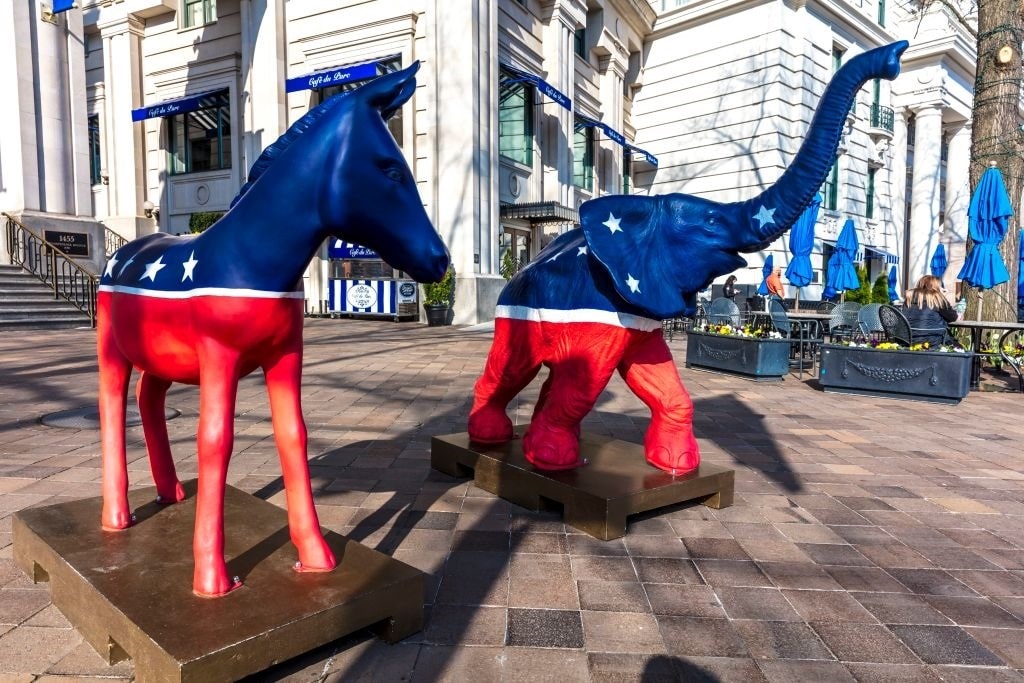We may be a country divided, but the gap between the political parties is shrinking. The Democrats held an edge from 2017 to 2021, but no longer. According to a recent Pew Research survey, Republicans have gained more registered voters and are closing in on the advantage as we head into the 2024 presidential election.
Republicans Gain on Democrats
Leading up to the 2020 election, Democrats had the advantage, with 51% of registered voters, compared to 46% Republicans. Pew Research now shows the tides are changing, with Dems posting 49% to the GOP at 48%. “The steadily growing alignment between demographics and partisanship reveals an important aspect of steadily growing partisan polarization,” Pew explained. “Republicans and Democrats do not just hold different beliefs and opinions about major issues, they are much more different racially, ethnically, geographically and in educational attainment than they used to be.”

Traditionally, black and Hispanic voters leaned left, but that has gradually been changing. Black voters who identified as Democrats dropped from 91% in 2016 to 83% in 2023, and Hispanic voters went from 68% in 2016 to 61% in 2023. Latinos have also switched support, according to the survey. President Biden’s favorability among this group has fallen by 7% since July. Former President Donald Trump, on the other hand, has gained 6% more support.
This is an important factor since 44% of Democratic voters are Asian, black, and Hispanic. Furthermore, Hispanic voters have nearly tripled since the 1990s, and Asian voters have increased sixfold over the same time, the survey revealed.
Racial demographics may not be the only contributing factor to the shrinking gap between political parties, but it is one of the largest influencers. The number of Asian, black, and Hispanic voters has grown quite a bit since 1996.
 Pew found that “the Democratic Party’s advantages among Black and Hispanic voters, in particular, have narrowed somewhat in recent years.” There are many possible reasons for this shift, but looking at today’s top concerns for Americans paints a clearer picture. On immigration, for which Republicans traditionally believe in stronger border security and policies, for example, 78% of those surveyed by Pew Research in January say the large number of migrants seeking to enter the country is either a crisis (45%) or a major problem (32%). Many blame Biden for the issue, as demonstrated by an Axios/Ipsos poll on April 11 that found only 22% of Latinos said the president is “good” on the issue.
Pew found that “the Democratic Party’s advantages among Black and Hispanic voters, in particular, have narrowed somewhat in recent years.” There are many possible reasons for this shift, but looking at today’s top concerns for Americans paints a clearer picture. On immigration, for which Republicans traditionally believe in stronger border security and policies, for example, 78% of those surveyed by Pew Research in January say the large number of migrants seeking to enter the country is either a crisis (45%) or a major problem (32%). Many blame Biden for the issue, as demonstrated by an Axios/Ipsos poll on April 11 that found only 22% of Latinos said the president is “good” on the issue.
The pendulum swing toward the Republican Party isn’t the first time in recent history. “[T]he general stability for the full-year average obscures a dramatic shift over the course of 2021,” according to a Gallup report from that period, “from a nine-percentage-point Democratic advantage in the first quarter to a rare five-point Republican edge in the fourth quarter.” Still, Democrats traditionally have a larger voter base, yet “Republicans held a five-point advantage in party identification and leaning in early 1995, after winning control of the House of Representatives for the first time since the 1950s. Republicans had a larger advantage only in the first quarter of 1991, after the U.S. victory in the Persian Gulf War led by then-President George H.W. Bush.”
The Changing Red and Blue Tides
Since the 1870s, Democrats have dominated, but that changed in 1964 when Lyndon Johnson beat Barry Goldwater,making it the first time in nearly 100 years that Republicans won most of the Deep South. The GOP continued to win the presidential election until 1992, except for 1976 when Jimmy Carter defeated Gerald Ford.

Photo by: Visions of America/Universal Images Group via Getty Images)
Current events and the way the president handles them weigh heavily in voters’ party preference. In 1976, for example, several factors contributed to the shifting from Republicans to Democrats, such as Watergate and Ford’s pardon of Richard Nixon.
Stanford political scientist Didi Kuo cited a number of reasons political parties are getting weaker in an interview with Stanford Report. The American people are “reckoning with a crisis of public confidence,” the outlet explained. “Political parties remain critical to organizing democracy but they are beleaguered,” Kuo added.
Until the 1970s, political parties enjoyed more power in selecting their party’s nominee for president. However, when Hubert Humphrey got the Democratic Party nomination in 1968 without even participating in the primary races, changes were made to give voters more power in the decision. “Political parties used to be gatekeepers in politics,” Kuo said. “Now, voters have a much bigger say in determining who’s going to be the presidential candidate.”
According to Kuo, another alteration that contributed to the change in political parties was the Bipartisan Campaign Reform Act of 2022, also known as McCain-Feingold, which limits the amount of financial contributions people can make. “That had the consequence of expanding the type of financing that donors would pursue outside of the party through 501(3)(4)s or super PACs.” She added:
“What we see is a world not just of parties trying to vie for seats in the legislature or candidates, but also of these external party organizations that sometimes are connected to the party and sometimes not. These groups can run their own ads, drum up support for their own issues, and collect a lot of money, sometimes undisclosed, on behalf of specific candidates and parties.”
When it comes to the 2024 presidential election, Kuo suggested that party-like organizations will be especially important. “Many groups are mobilizing voters around specific issues, such as abortion rights, while others may mobilize for and against specific candidates, like the faction of ‘Never-Trumpers’ from 2020.”
Another issue is that people feel estranged from their political parties. This is one reason the No Labels organization gained in popularity, even though it has no candidate to put on this presidential ticket. It’s not necessarily that people are divided on issues, Stanford pointed out, “it is the political class that has become more polarized, leading voters to feel alienated from their party.”
Now, as we head into the 2024 election, Biden has a lot to contend with. Recent polls show the president is not viewed favorably on Americans’ hot-button issues. Immigration, for instance, is no longer just a crisis along the border; it has become a problem across the nation and especially in Democrat-run states and cities. The cost of living makes it difficult for many citizens to afford basic essentials, such as food and housing, while illegal migrants get those and other benefits for free. And with the shift to more Republicans voting, the nation may once again be turning more red than blue.

